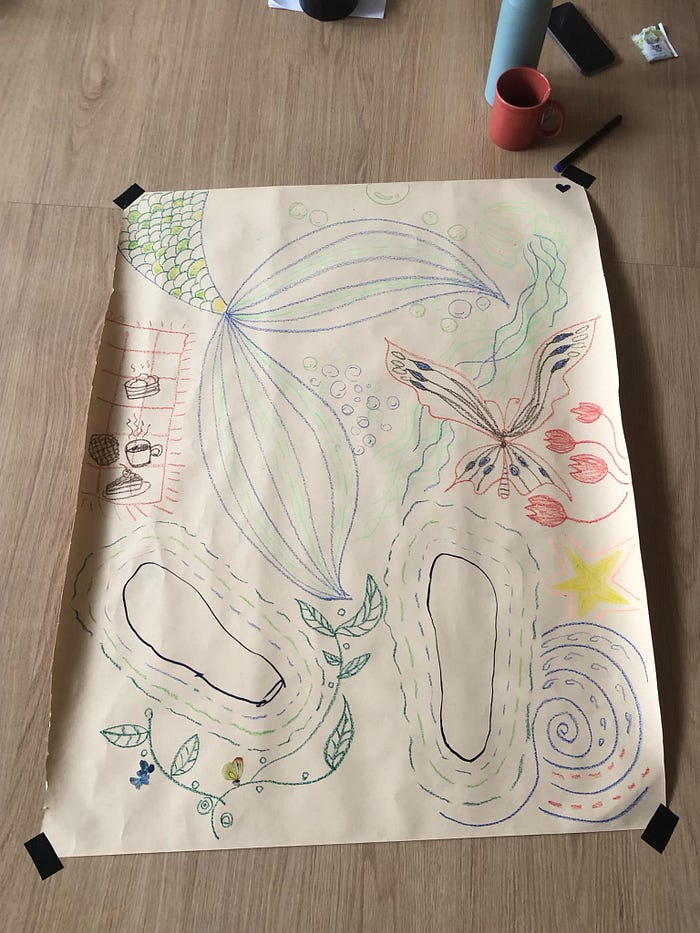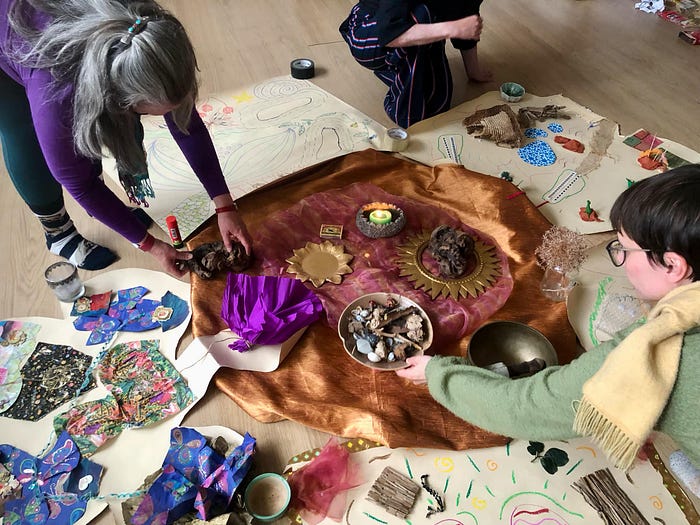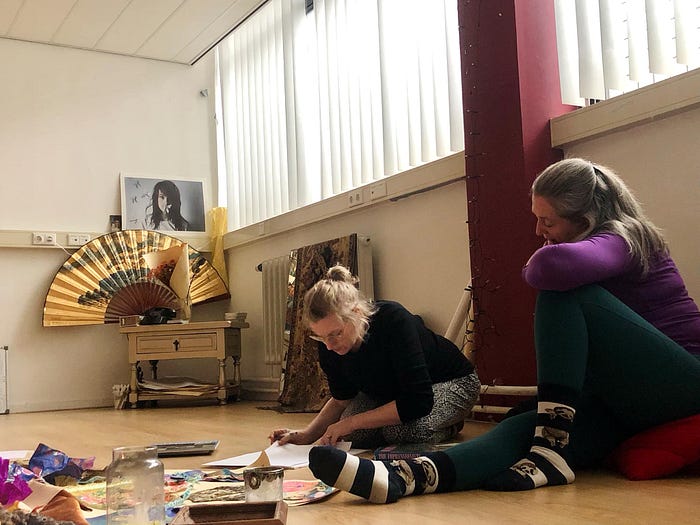At NEXAA, expressive arts workshops are designed to hold space for self-exploration, emotional grounding, and creative connection. Through guided meditation, movement, and imaginative art-making, participants are invited to tune into their inner landscapes and transform emotional experiences into visual and poetic expressions. This blog shares a personal reflection from one such workshop — centered around the theme of creating your own emotional “continent.”
Arriving in a Safe Space
How can you create your own continent?
How do you stay grounded?
How can you create a safe space to fall into when you are in need?
When there are many uninvited or poisonous judgments rising from the outside world, how do we navigate through them, ride with the waves, and find the inner peace to validate our emotions and let them go?
When I stepped into the room, the chaos from the outside world suddenly shut off completely as I closed the door. Coming to the event a bit late, I felt a sense of shame, guilt, and turbulence, fooled by Google Maps circling me around under the rusty wind and rain.
Everyone greeted me with a quick warm nod, and Hannah smiled at me with a gentle “hi,” while Suzan lowered her voice and waved at me. I suddenly felt all the self-sabotaging talk before entering the workshop vanish.
Setting the Scene: A Welcoming Circle
Sitting in a circle, each person had piles of comfy cushions, their mug, and plates with some snacks, all centered around delicate decorations layered over several fabrics. The textures and visuals felt warm and cozy in the candlelight. I immediately felt grounded, and my sensing of everyone’s energies and presence expanded. I started to feel curious about how everyone got to know this workshop, and how lucky we were to be able to spare this common time on a Saturday to experience this expressive arts workshop together.
My mind drifted to the idea of “緣” (yuan), which in Mandarin means the bond and connection between two people — a sense of serendipity and unconditional bond from beyond us. I think there was something special that brought us together at the same time here. Hannah kept on reading out loud while my gaze stopped on the book beside her: Braiding Sweetgrass: Indigenous Wisdom, Scientific Knowledge and the Teachings of Plants.

Movement, Permission, and Acceptance
Later, we were invited to a guided meditation. Suzan’s soothing voice led me into a very calming and relaxing state. We were encouraged to do a body scan, paying attention to each body part and moving naturally with it. I started to move my limbs, stretch them, take the space I needed, and feel how my body wanted to move. I felt I was being given permission to move at whatever pace and in whatever position I wanted. And the best part was, I didn’t need to be a professional dancer or incredibly flexible. I didn’t need to prove myself to anybody. I felt fully accepted, allowed, and celebrated.
Creating Our Continents
After the body scan, we spread the sheets and decided how big we wanted our canvas — our continent — to be. At this point, our group started to make small talk and smile at each other naturally, offering help with cutting the paper. I was gently asked to introduce myself, since I had arrived later. After the grounding guided movements, I also felt more open and relaxed. Self-introductions were less stressful and less forced. I remember sharing five traits of “I am…” and “I love…” — including loving oyster omelet, animals, visiting museums, and crystals, and how I am like a sloth sometimes, super slow with things. I barely mentioned that I am a Master’s student or my nationality. The formality and seriousness melted away naturally. I felt that my weirdness would be fully accepted and allowed.
We laid the canvas on the ground, stepped on it, and used a marker to circle both our feet. Starting from there, we created our imaginary continent. Suzan played some gentle ambient music in the background, which helped me sink deeper into my thoughts and imagination. I drew a mermaid tail, butterfly, greenery, jellyfish, and ocean waves, along with a picnic blanket with dim sum, coffee cups, and stroopwafels on it.

Coming Together in Consent and Collaboration
After completing our own continent, we were encouraged to put our continents together and make a whole picture. Aesthetic considerations emerged — some replaced tape with prettier mugs, while others brought a large branch to place between two different canvases. Suzan reminded us that if we wanted to move or change any part of someone else’s continent, we should gently ask and be prepared for the possibility of rejection. The adjustments were done with polite and heartfelt consent. And I love that for us.

Poetic Reflections and Shared Meaning
Later, we were asked to create a journal entry describing our continent in poem form. Each person shared their poem, and it was a very genuine and sacred moment to try to understand others’ continents through their words. One of us had glittery boundaries on their continent, one used 3D decorations including a small dinosaur, and one was reminded of childhood hobbies through a magazine collage. Each person picked multiple materials to create their piece.
Hannah and Suzan helped us create a collective poem at the end of the session as a wholesome finish. We shared our feelings and thoughts about the workshop. I felt my heart open wider, my emotions pampered, and my anger and insecurities from a chaotic, bustling week acknowledged and soothed.

Carrying It Home
It was raining heavily on my way home. My clothes were soaked, my shoes covered in mud. But despite the mess, I felt peaceful. Although I left my “continent” in the workshop studio, I carried something meaningful with me — a sense of belonging, calm, and inner grounding.
I can be my own home.
Coles and Jury (2020) write that museum-based art activities help people reclaim identities beyond their roles as patients, sparking creativity, emotional connection, and shared understanding (Coles and Jury 2020, 122).
Similarly, in this workshop, I wasn’t “treated,” but I felt deeply seen and held. We created a safe, welcoming space where everyone shared their own journey of belonging. Through that, we built social bonds that made us feel less alone.
In the end, it reminded me that no matter our background, we all long for the same things: to love and be loved, to belong, and to feel alive.

Reference:
Coles, Ali, and Helen Jury 2020. “ART THERAPY in MUSEUMS AND GALLERIES.” Jessica Kingsley Publishershttps://www.jkp.com.